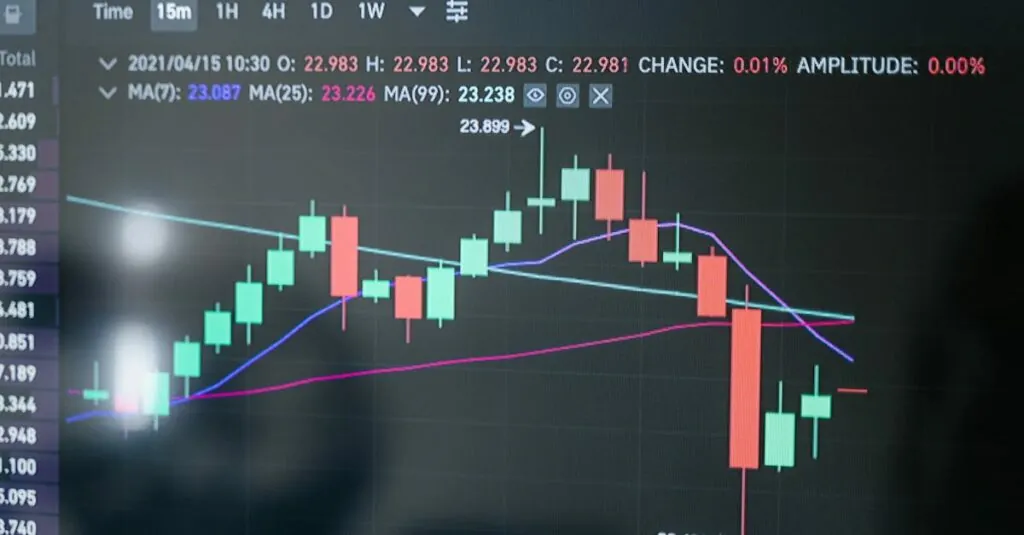Table of Contents
ToggleThe stock market: a thrilling rollercoaster ride where fortunes can soar or plummet faster than a cat chasing a laser pointer. Investors watch with bated breath, wondering when the next crash might hit. It’s like waiting for a surprise party—except the surprise is a nosedive in their portfolio.
With so many factors at play, predicting a crash feels a bit like trying to forecast the weather in a tornado. Is it a storm brewing on the horizon, or just a passing cloud? Understanding the signs and signals can help investors navigate these turbulent waters and maybe even dodge the next big dip. Buckle up and get ready to dive into the world of market predictions and what they mean for your investments.
Understanding Stock Market Crashes
Grasping stock market crashes involves analyzing patterns and recognizing triggers. Investors play a crucial role in interpreting these shifts.
Historical Context
History reveals that significant crashes often stem from economic bubbles or external shocks. The Great Depression in 1929 marks a severe downturn, leading to a loss of nearly 90%. The dot-com bubble in 2000, driven by irrational exuberance in technology stocks, decreased market value by 78%. Information about these events can help investors recognize repeated patterns. Learning from past events provides a foundation for understanding current market behavior. Familiarity with the timeline of historical crashes aids in identifying similar circumstances today.
Economic Indicators
Economic indicators serve as vital tools for predicting potential downturns. Unemployment rates, interest rates, and inflation statistics each provide insights into market health. Rising unemployment often signals economic distress, while escalating interest rates can restrict borrowing and spending. Additionally, an increase in inflation may erode purchasing power, impacting consumer spending. Analysts often watch these key metrics to gauge market sentiment. Monitoring several indicators simultaneously enhances the ability to anticipate future market behavior. Understanding these connections enables investors to make informed decisions.
Factors Influencing Market Stability
Market stability hinges on several key factors that warrant attention from investors. Recognizing these can enhance the ability to predict downturns effectively.
Interest Rates and Inflation
Interest rates and inflation significantly affect market dynamics. Rising interest rates typically lead to higher borrowing costs, dampening consumer spending and business investment. Market participants often react negatively to these rate hikes, resulting in stock sell-offs. Conversely, low interest rates stimulate economic activity, creating a favorable environment for stronger market performance. Inflation, on the other hand, erodes purchasing power, influencing consumer behavior and corporate earnings. Sustained high inflation can also pressure central banks to increase interest rates, further impacting market stability.
Geopolitical Events
Geopolitical events shape investor sentiment and market reactions. Tensions arising from conflicts, trade disputes, or political instability can create uncertainty, leading to market volatility. For instance, military conflicts often trigger sell-offs in sensitive sectors, such as energy or defense. Meanwhile, trade tensions can disrupt supply chains, prompting investors to reassess risk. Major elections or shifts in government policies also sway markets as participants anticipate potential changes in economic direction. Keeping an eye on global developments allows investors to make timely decisions based on the evolving landscape.
Predictions and Analysis
Predicting stock market crashes involves assessing various sources and methodologies. Analysts rely on expert opinions and statistical models for insights into potential downturns.
Expert Opinions
Leading analysts often provide insightful perspectives on market trends. Many experts point to historical data as a foundation for predictions. In their reviews, they cite major market events that preceded crashes, emphasizing common signs such as overvaluation or economic instability. Investors may find it valuable to track sentiment analysis, which gauges investor confidence. This feedback can indicate shifts in the market’s direction. Additionally, some experts stress the importance of geopolitical factors, which can create unpredictable conditions that influence market behavior.
Statistical Models
Quantitative analysts frequently utilize statistical models to forecast market movements. These models rely on current and historical data to identify patterns that may signal a downturn. Common examples include regression analysis and Monte Carlo simulations. Historical volatility tracked through these models often reveals correlations between market indicators and potential crash events. Moreover, data-driven insights from models like the ARIMA (Auto-Regressive Integrated Moving Average) assist in creating projections based on trends. By regularly analyzing these statistics, investors can stay informed about potential risks and adapt strategies accordingly.
Signs of an Impending Crash
Monitoring the stock market involves recognizing specific signals that may indicate an upcoming crash. Identifying these signs can enhance investors’ ability to react proactively.
Market Trends to Watch
Investors should watch for prolonged declines in major indices like the S&P 500 and Dow Jones. Rising volatility often corresponds with market uncertainty, suggesting a potential downturn. Additionally, decreasing trading volume during price increases may indicate weakening investor interest, a common precursor to crashes. Overvaluation within key sectors is another critical factor, evidenced by price-to-earnings ratios reaching unsustainable levels. Awareness of these trends helps investors pinpoint vulnerable areas within the market.
Behavioral Indicators
Shifts in investor sentiment can offer important clues about impending crashes. Increasing levels of fear, evidenced by a rise in the VIX, point to heightened market anxiety. Additionally, herd behavior, where investors follow others rather than analyzing fundamentals, often leads to inflated asset prices. Heavy margin trading indicates excessive risk-taking that typically accompanies market bubbles. Finally, the presence of widespread overconfidence may reflect unsustainable optimism, setting the stage for future corrections. Recognizing these behavioral indicators enhances an investor’s awareness of potential risks.
Navigating the stock market’s unpredictable nature requires vigilance and awareness. By staying informed about economic indicators and recognizing warning signs, investors can better position themselves against potential downturns. Understanding historical patterns and the factors that influence market stability is crucial for making informed decisions.
As the market continues to evolve, being proactive and adaptable will empower investors to respond effectively to fluctuations. While predicting a crash may be elusive, the right strategies and insights can help mitigate risks and enhance long-term investment success. Embracing a thoughtful approach will ultimately lead to more resilient financial futures.




